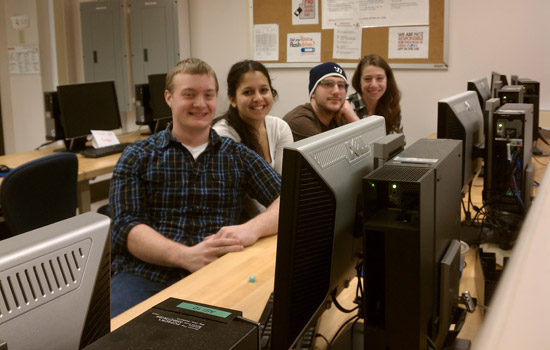RIT Students Win National Material Handling Design Competition
Project plan details cost effective, efficient and automated manufacturing facility
Provided by Matthew Myers
Undergraduates in the industrial and systems engineering program, (from left) Matthew Myers, Leila Rozenman, Austin Chacosky and Bridget Eggers, took top honors in the recent College Industry Council of Material Handling education student design competition.
Students from Rochester Institute of Technology found that good design is not just what something looks like, but how well it works.
Four students from RIT’s industrial and systems engineering program built a model manufacturing plant that won first place in the 2011–2012 College Industry Council on Material Handling Education student design competition. The organization announced in August the winning collegiate teams from its annual national competition.
This was the first year the RIT team took top honors at the national event. The $2,000 award will be split among the team, Matthew Myers, Austin Chacosky, Bridget Eggers and Leila Rozenman, all undergraduates in RIT’s Kate Gleason College of Engineering.
“We had the right group of people for this. Austin was a wizard at data mining and Leila did an incredible job on her financial justifications. Bridget made a really efficient and aesthetically pleasing layout for the facility, and we each did a little of everything,” says Myers, a fourth-year student. “We built the most efficient facility at the least cost and it was fully automated with robotic systems and conveyers.”
Participating universities used a real-world case study developed by the College Industry Council and its partner organization, the Material Handling Industry of America. At RIT, the case was incorporated into an engineering class, Systems and Facilities Planning, taught by Andres Carrano, associate professor of industrial and systems engineering, during winter quarter.
The model designed had to include not only equipment placement in the physical space, but the material handling, supply chain management and logistical coordination needed for a fully-functioning steel tool plant and distribution center, he says. The engineering class had five weeks to complete the project, and the best plan from the class was submitted for the competition.
“Finding out we won for the class was pretty exciting, but finding out we won the whole national competition was just awesome,” Eggers says. “We ended up spending our Valentine’s Day dinner together eating pizza in the computer lab working in the project. That’s dedication.”
Chacosky agreed. He and Myers worked on the production plan and machine selection, using RIT’s research computing facilities to analyze data and do modeling. Myers, who also works in RIT’s Brinkman Machine Tools and Manufacturing Laboratory and is familiar with manufacturing operations, contributed to the factory drawing and layout work. Eggers, the unofficial project manager, kept the team on track to meet production goals, and designed the material flow and machine placement.
“The fact the RIT team took first place speaks volumes about the caliber of our students,” Carrano says. “They competed against teams from top universities around the country, several with graduate students on those teams. I know the judging is very rigorous with a panel of consultants and academics in the area of material handling.”















